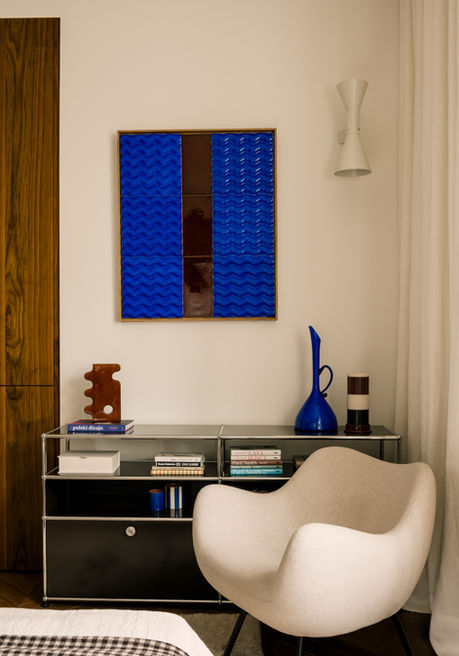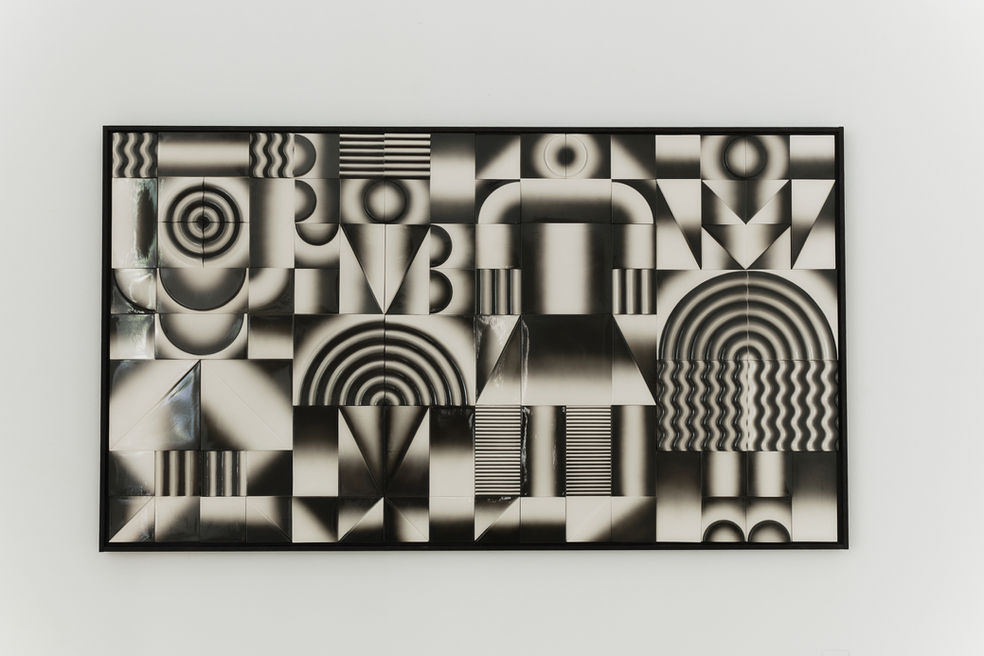OP
We created the OP objects to reveal the extraordinary relationship between color and light. They are a tribute to color and its ability to surprise, transform, and delight. We also wanted both literally and metaphorically to shed light on the material beauty of ceramics, a medium that has captured our professional lives.
Color and light are inseparable. Light creates color and changes the relationships between colors. A light wave has no color, and neither does the surface it illuminates. Color gains its human meaning only through processes occurring in the eye and brain. This means there are colors we will never know, as our eyes can only perceive light waves of specific lengths. One could even say that colors do not exist without our experience of them.
OP objects explore the world of optical phenomena, based on the mutual interplay of light, color, form, and human perception. They are instruments for experimenting with vision. When placed in the gallery space, they form a living composition in which the human presence plays a crucial role. The components of this collection, connected by a subtle web of physical laws, enter into dynamic relationships casting light, reflecting it, covering one another in shadow, exchanging colors.
Cool blues disappear under the light of a bulb, while warm yellows reveal their fiery nature. With the viewer’s movement and changing light conditions, the colors shimmer, glow, blaze, caress, clash, fade, dull, and deceive and we allow ourselves to be fooled. The elusive nature of these phenomena makes us aware that the boundary between reality and perception is fluid.The OP collection consists of objects emitting their own light and reflecting it.
OP Wall - ceramic tiles, threaded onto brass rods, rotate around their own axis, opening or closing the space. The artists envisioned these as interactive images, whose open form allows viewers to create new compositions. The front and back are two separate images, which blend into each other through touch. Each rotated tile changes the arrangement on both sides. As a result, a wall of seventy tiles can form 1,180,591,620,717,411,303,424 possible configurations. This number is about 150 times greater than the number of all grains of sand on Earth and slightly smaller than the number of atoms in the human body. The poetry of this number evokes a kind of melancholy, stemming from the impossibility of ever testing all combinations. In this situation, the obsession with creative control disappears, replaced by the pleasure of experimenting with infinite variations alongside the participants in the experience.
TRN
Calligraphic forms, bold colors, fine materials and craft techniques. The new TRN collection of Pani Jurek is a homage to the art of Jan Tarasin.
A fascination with Jan Tarasin paintings and graphics was a starting point for the creation of the whole collection. Tarasin was interested in the world of objects. He began with realistic record objects that he simplified and reduced until a system of abstract signs was formed. In her latest collection, Pani Jurek reverses this process, turning ideograms into things again. Her three dimensional objects have a simple calligraphic form so they can play and talk together as if they were letters from a non-existent alphabet.
"Looking for the form of an object, placing things in the space or building the relation between them, is all “visual thinking” to me. I am also a painter by education and picture thinker. I believe we all are. Furnishing the apartment or setting the table, more or less consciously, means that everyday we are creating an infinite number of compositions, that all refer to our sense of harmony and proportion" - Magda Jurek
There are 5 models of side tables in the collection, 8 of mirrors and ceramic lighting fixtures, whose single elements can be arranged into the compositions. The hand crafted process of glazing ceramics and furniture making gives the collection a truly unique character. Each piece is one of a kind.
The furniture is made in cooperation with Square Drop, conservative lab and bespoke furniture studio. Hand crafted in solid ash wood, with traditional cabinet making techniques, the furniture is wood stained and covered with natural wax. Ceramic lighting fixtures are finished with brass elements.
The collection is made for residential and commercial spaces. Objects can be arrange together like blocks of a puzzle, but, due to their sculptured look, they also suit perfectly as single accent pieces in a private apartment.
POLA
POLA (English: fields) is a serie of ceramic artworks inspired by the abstract world of op-art and the ceramic monumental art of the modernism era.
Ceramic tile compositions combine vibrant colors with spatial patterns. Light plays on their geometric, convex surfaces. Contrasting textures of glossy and matte glazes, along with the engobe, refers to the sense of touch. Hand-glazed modules captivate with rich hues and depth. Colors accentuate the tiles' geometric shapes. Even the shadows get hues.
There is a joy of creation in these compositions, as well as precision, especially visible in the gradient transitions of glazes, which closely resemble subtle pencil shading. Ceramics, in which colors cannot be seen before firing, and "you use colors that you imagine" (Bolesław Książek), is an activity that requires excellent craftsmanship and painter’s imagination.
In these ceramic artworks, which straddle the boundary between abstraction and figurative painting, we can find echoes of the works of Wojciech Fangor, Fernand Léger, Kazimierz Malevich and Stefan Gierowski. In the idea of the collection - the fascination with the "Wizard of Łysa Góra", ceramicist Bolesław Książek. The Kamionka Cooperative of Folk and Artistic Industry operated in Łysa Góra, which he ran since 1951, produced big scale ceramic compositions for the architecture in cooperation with artists.
Text: Aleksandra Kędziorek
ELO Mirrors
In the ELO mirrors collection, Pani Jurek explores ceramics and the reflective potential of mirror surfaces. Inspired by the ripple effect on water, the sculptural frames mimic the expanding circles that appear after a splash. The ceramic elements are airbrushed glazed by hand, which gives them a unique, artisanal character. The name "ELO" is a playful nod to Polish slang for "hello," referring to the greeting between you and your reflection in the mirror.
BARVA Vases
Vibrant color spots, wavy lines, contrasts, textures and subtle tonal transitions. In her newest collection of ceramic vases Pani Jurek uses the language of painting.
The four flat shapes of matching vases may be arranged into various configurations. This collection is focused on combining abstract geometric forms of objects with the organic world of plants to offer endless possibilities and emphasize beauty based in opposition. The name of the collection - BARVA - refers to the theory and reception of colors as a compilation of objective physical properties and a viewer’s subjective feelings. The vases come in a limited color series. The manual process of glazing and engobing provides the opportunity to develop surprising colors and achieve non-obvious tonal transitions. BARVA vases, especially when placed together, look attractive without any plants as independent abstract compositions. The designs may also be mounted on the wall, using designated hangers, to form unique decorative relief.

































